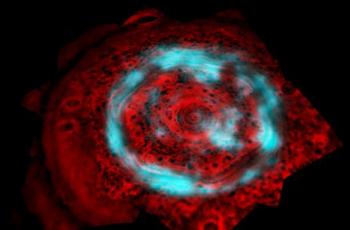Aurora over saturns north pole mystifies scientists
15 Nov 08, 06:40pm

15 Nov 08, 06:40pm

Scientists are confused over a mysterious aurora on Saturn's north pole, because it behaves unlike any other known aurora found in the Solar system.
This was revealed by an infra-red camera carried by Cassini spacecraft. CassiniâHuygens is a joint venture by NASA, European Space Agency and ASI, currently studying the planet Saturn and its moons.
Cassini-Huygens is one of the most ambitious missions ever launched into space. Cassini was launched on October 15, 1997 and it reached Saturn's orbit on July 1, 2004.
Cassini revealed many valuable information to mankind about Saturn and its largest moon Titan. During its Saturn probe for the last four years, Cassini discovered many small moons of Saturn.
In 2006, scientists discovered a storm at the south pole of Saturn similar to hurricanes on Earth, that had never been seen on any other part of Solar system.
It's not just a ring of auroras like those seen at Jupiter or Earth. This aurora covers an enormous area across the pole. The image shown on the left is a composite, displaying the aurora, illustrated in bluish-green, the planetâs hot interior, rendered in red, and clouds, which appear as black silhouettes.
This was revealed by an infra-red camera carried by Cassini spacecraft. CassiniâHuygens is a joint venture by NASA, European Space Agency and ASI, currently studying the planet Saturn and its moons.
Cassini-Huygens is one of the most ambitious missions ever launched into space. Cassini was launched on October 15, 1997 and it reached Saturn's orbit on July 1, 2004.
Cassini revealed many valuable information to mankind about Saturn and its largest moon Titan. During its Saturn probe for the last four years, Cassini discovered many small moons of Saturn.
In 2006, scientists discovered a storm at the south pole of Saturn similar to hurricanes on Earth, that had never been seen on any other part of Solar system.
It's not just a ring of auroras like those seen at Jupiter or Earth. This aurora covers an enormous area across the pole. The image shown on the left is a composite, displaying the aurora, illustrated in bluish-green, the planetâs hot interior, rendered in red, and clouds, which appear as black silhouettes.
 Amaran
Amaran Brother
Brother Lucky Baskhar
Lucky Baskhar Vettaiyan
Vettaiyan Meiyazhagan
Meiyazhagan Thangalaan
Thangalaan The Greatest Of All Time
The Greatest Of All Time Mazhai Pidikkatha Manithan
Mazhai Pidikkatha Manithan